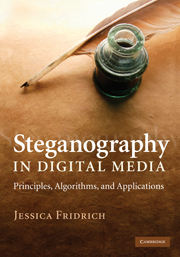Book contents
- Frontmatter
- Dedication
- Contents
- Preface
- Acknowledgments
- 1 Introduction
- 2 Digital image formats
- 3 Digital image acquisition
- 4 Steganographic channel
- 5 Naive steganography
- 6 Steganographic security
- 7 Practical steganographic methods
- 8 Matrix embedding
- 9 Non-shared selection channel
- 10 Steganalysis
- 11 Selected targeted attacks
- 12 Blind steganalysis
- 13 Steganographic capacity
- A Statistics
- B Information theory
- C Linear codes
- D Signal detection and estimation
- E Support vector machines
- Notation and symbols
- Glossary
- References
- Index
- Plate section
9 - Non-shared selection channel
Published online by Cambridge University Press: 05 April 2014
- Frontmatter
- Dedication
- Contents
- Preface
- Acknowledgments
- 1 Introduction
- 2 Digital image formats
- 3 Digital image acquisition
- 4 Steganographic channel
- 5 Naive steganography
- 6 Steganographic security
- 7 Practical steganographic methods
- 8 Matrix embedding
- 9 Non-shared selection channel
- 10 Steganalysis
- 11 Selected targeted attacks
- 12 Blind steganalysis
- 13 Steganographic capacity
- A Statistics
- B Information theory
- C Linear codes
- D Signal detection and estimation
- E Support vector machines
- Notation and symbols
- Glossary
- References
- Index
- Plate section
Summary
In Chapter 6, we learned that steganographic security can be measured with the Kullback–Leibler divergence between the distributions of cover and stego images. Four heuristic principles for minimizing the divergence were discussed in Chapter 7. One of them was the principle of minimal embedding impact, which starts with the assumption that each cover element, i, can be assigned a numerical value, ρ[i], that expresses the contribution to the overall statistical detectability if that cover element was to be changed during embedding. If the values ρ[i] are approximately the same across all cover elements, minimizing the embedding impact is equivalent to minimizing the number of embedding changes. The matrix embedding methods introduced in the previous chapter can be used to achieve this goal.
If ρ[i] is highly non-uniform, Alice may attempt to restrict the embedding changes to a selection channel formed by those cover elements with small ρ[i]. Constraining the embedding process in this manner, however, brings a fundamental problem. Often, the values ρ[i] are computed from the cover image or some side-information that is not available to Bob. Thus, Bob is generally unable to determine the same selection channel from the stego image and thus read the message. Channels that are not shared between the sender and the recipient are called non-shared selection channels. The main focus of this chapter is construction of methods that enable communication with non-shared selection channels.
- Type
- Chapter
- Information
- Steganography in Digital MediaPrinciples, Algorithms, and Applications, pp. 167 - 192Publisher: Cambridge University PressPrint publication year: 2009



